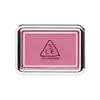3CE New Take Face Blusher Versus Creer Beaute Miracle Romance Sailor Moon Rainbow Moon Chalice Cheek
What's inside
What's inside
 Key Ingredients
Key Ingredients

 Benefits
Benefits

No benefits
 Concerns
Concerns

 Ingredients Side-by-side
Ingredients Side-by-side

Talc
AbrasiveMica
Cosmetic ColorantSynthetic Fluorphlogopite
Boron Nitride
AbsorbentTitanium Dioxide
Cosmetic ColorantDimethicone
EmollientSilica
AbrasiveMagnesium Stearate
Cosmetic ColorantDiisostearyl Malate
EmollientPhenyl Trimethicone
Skin ConditioningDipentaerythrityl Hexahydroxystearate/Hexastearate/Hexarosinate
Skin ConditioningCI 15850
Cosmetic ColorantGlyceryl Caprylate
EmollientCaprylyl Glycol
EmollientTriethoxycaprylylsilane
Ultramarines
CI 77492
Cosmetic ColorantCI 77491
Cosmetic ColorantTalc, Mica, Synthetic Fluorphlogopite, Boron Nitride, Titanium Dioxide, Dimethicone, Silica, Magnesium Stearate, Diisostearyl Malate, Phenyl Trimethicone, Dipentaerythrityl Hexahydroxystearate/Hexastearate/Hexarosinate, CI 15850, Glyceryl Caprylate, Caprylyl Glycol, Triethoxycaprylylsilane, Ultramarines, CI 77492, CI 77491
Talc
AbrasiveSynthetic Fluorphlogopite
Methyl Methacrylate Crosspolymer
Squalane
EmollientSimethicone
EmollientBoron Nitride
AbsorbentDiisostearyl Malate
EmollientPhytosteryl/Isostearyl/Cetyl/Stearyl/Behenyl Dimer Dilinoleate
Skin ConditioningSorbitan Sesquiisostearate
EmulsifyingAluminum Distearate
Emulsion StabilisingEthylparaben
PreservativeMethylparaben
PreservativeHydrogenated Polyisobutene
EmollientCI 77480
Cosmetic ColorantTocopheryl Acetate
AntioxidantWater
Skin ConditioningButylene Glycol
HumectantAlcohol Denat.
AntimicrobialPyrus Pyrifolia Fruit Extract
EmollientPrunus Armeniaca Kernel Extract
Skin ConditioningPrunus Persica Kernel Extract
MoisturisingAbelmoschus Esculentus Fruit Extract
Skin ConditioningHydrogen Dimethicone
Mica
Cosmetic ColorantIron Oxides
Titanium Dioxide
Cosmetic ColorantAluminum Hydroxide
EmollientSilica
AbrasiveBrassica Rapa Leaf Extract
Skin ConditioningCI 73360
Cosmetic ColorantTalc, Synthetic Fluorphlogopite, Methyl Methacrylate Crosspolymer, Squalane, Simethicone, Boron Nitride, Diisostearyl Malate, Phytosteryl/Isostearyl/Cetyl/Stearyl/Behenyl Dimer Dilinoleate, Sorbitan Sesquiisostearate, Aluminum Distearate, Ethylparaben, Methylparaben, Hydrogenated Polyisobutene, CI 77480, Tocopheryl Acetate, Water, Butylene Glycol, Alcohol Denat., Pyrus Pyrifolia Fruit Extract, Prunus Armeniaca Kernel Extract, Prunus Persica Kernel Extract, Abelmoschus Esculentus Fruit Extract, Hydrogen Dimethicone, Mica, Iron Oxides, Titanium Dioxide, Aluminum Hydroxide, Silica, Brassica Rapa Leaf Extract, CI 73360
Ingredients Explained
These ingredients are found in both products.
Ingredients higher up in an ingredient list are typically present in a larger amount.
Boron Nitride is compound consisting of boron and nitrogen. It is used to absorb oil and modify adherence/ slip in products.
This means it is often used in makeup products to help them last longer.
Diisostearyl Malate is an emollient and most often used in lip products. It comes from isostearyl alcohol, a fatty acid, and malic acid, an AHA.
As an emollient, Diisostearyl Malate helps create a thin film on your skin to trap moisture in. This helps keep your skin soft and smooth.
Mica is a naturally occurring mineral used to add shimmer and color in cosmetics. It can also help improve the texture of a product or give it an opaque, white/silver color.
Serecite is the name for very fine but ragged grains of mica.
This ingredient is often coated with metal oxides like titanium dioxide. Trace amounts of heavy metals may be found in mica, but these metals are not harmful in our personal products.
Mica has been used since prehistoric times throughout the world. Ancient Egyptian, Indian, Greek, Roman, Aztec, and Chinese civilizations have used mica.
Learn more about MicaSilica, also known as silicon dioxide, is a naturally occurring mineral. It is used as a fine, spherical, and porous powder in cosmetics.
Though it has exfoliant properties, the function of silica varies depending on the product.
The unique structure of silica enhances the spreadability and adds smoothness, making it a great texture enhancer.
It is also used as an active carrier, emulsifier, and mattifier due to its ability to absorb excess oil.
In some products, tiny microneedles called spicules are made from silica or hydrolyzed sponge. When you rub them in, they lightly polish away dead skin layers and enhance the penetration of active ingredients.
Learn more about SilicaSynthetic Fluorphlogopite is the synthethic version of mica. It consists of fluorine, aluminum and silicate.
Synthetic Fluorphlogopite is used to add volume to products.
It is considered non-irritating on the skin.
Learn more about Synthetic FluorphlogopiteTalc is a clay mineral. It helps absorb moisture and improve the texture of products. Like other types of clay, Talc can have a slight exfoliating effect on skin. Talc can be added to increase the volume of products.
Some Baby powders are made by combining talc with corn starch. The word "talc" comes from Latin and originates from Arabic. Talc is a mineral commonly found throughout the world.
If you have any concerns about using talc, we recommend checking out the FDA's official page.
Learn more about TalcTitanium dioxide is a mineral UV filter widely used in sunscreens and cosmetics.
It is one of only two UV filters officially classified as “mineral” by regulatory agencies, the other being zinc oxide.
Titanium dioxide provides broad-spectrum protection mostly in the UVB and UVAII range, with some protection in the UVAI range.
While its UVA protection isn’t as strong as zinc oxide’s, the difference is minor.
A common myth is that mineral UV filters reflect UV light. However, modern research shows titanium dioxide absorbs UV radiation like chemical filters (~95% absorption & 5% reflection).
Thanks to its non-irritating nature, titanium dioxide is suitable for sensitive, acne-prone, or redness-prone skin. It is unlikely to cause "eye sting" like other sunscreen ingredients.
A major drawback of this ingredient is its white cast and thick texture. This is why mineral sunscreens often leave a white cast and are less cosmetically elegant than chemical/hybrid sunscreens.
To improve white cast and spreadability, micronized or nano-sized titanium dioxide is often used.
There are ongoing concerns surrounding nano-titanium oxide's impact on marine ecosystems.
There is no conclusive evidence that any form of titanium oxide (or any other sunscreen ingredients) will cause harm to marine ecosystems or coral reefs. The science is still developing but many consumers are keeping a close eye on this issue.
Please note, many destinations have reef-safety sunscreen rules. For instance, the U.S. Virgin Islands advises all visitors to use non-nano mineral sunscreens.
Nano mineral sunscreens once raised safety concerns about absorption into skin.
Extensive research has shown that they do not penetrate healthy or damaged skin; they remain safely on the surface and the top layer of dead skin (stratum corneum).
You'll likely find titanium dioxide bundled with alumina, silica, or dimethicone. These ingredients help make titanium dioxide highly photostable; this prevents it from interacting with other formula components under UV light.
Learn more about Titanium Dioxide